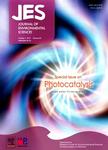Optimization of phenol degradation by Candida tropicalis Z-04 using Plackett-Burman design and response surface methodology
Optimization of phenol degradation by Candida tropicalis Z-04 using Plackett-Burman design and response surface methodology作者机构:School of Environmental Science and Engineering Shanghai Jiaotong University Dongchuan Road 800 Shanghai 200240 China.
出 版 物:《Journal of Environmental Sciences》 (环境科学学报(英文版))
年 卷 期:2011年第23卷第1期
页 面:22-30页
核心收录:
学科分类:0710[理学-生物学] 0832[工学-食品科学与工程(可授工学、农学学位)] 07[理学] 08[工学] 071007[理学-遗传学] 083203[工学-农产品加工及贮藏工程]
基 金:supported by the National Natural Science Foundation of China (No.50778110)
主 题:phenol degradation Candida tropicalis Z-04 optimization Plackett-Burman design response surface methodology
摘 要:Statistical experimental designs were used to optimize the process of phenol degradation by Candida tropicalis Z-04, isolated from phenol-degrading aerobic granules. The most important factors influencing phenol degradation (p 〈 0.05), as identified by a two-level Plackett-Burman design with 11 variables, were yeast extract, phenol, inoculum size, and temperature. Steepest ascent method was undertaken to determine the optimal regions of these four significant factors. Central composite design (CCD) and response surface analysis were adopted to further investigate the mutual interactions between these variables and to identify their optimal values that would generate maximum phenol degradation. The analysis results indicated that interactions between yeast extract and temperature, phenol and temperature, inocuhim size and temperature affected the response variable (phenol degradation) significantly. The predicted results showed that the maximum removal efficiency of phenol (99.10%) could be obtained under the optimum conditions of yeast extract 0.41 g/L, phenol 1.03 g/L, inoculum size 1.43% (V/V) and temperature 30.04℃. These predicted values were further verified by validation experiments. The excellent correlation between predicted and experimental values confirmed the validity and practicability of this statistical optimum strategy. This study indicated the excellent ability of C. tropicalis Z-04 in degrading high-strength phenol. Optimal conditions obtained in this experiment laid a solid foundation for further use of this microorganism in the treatment of highstrength phenol effluents.



